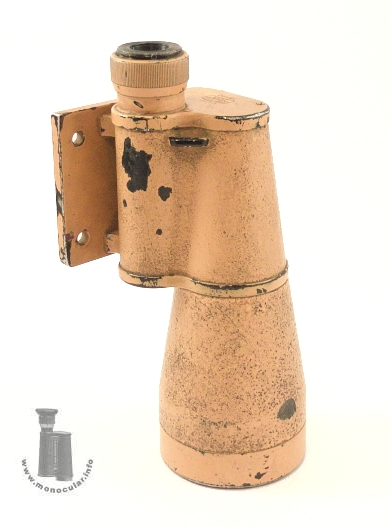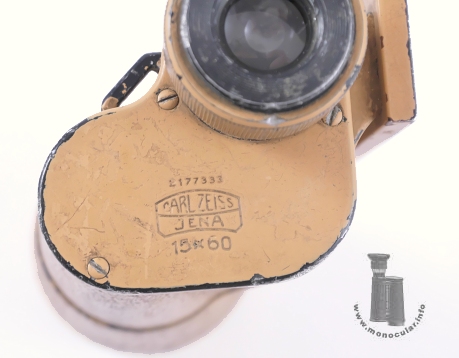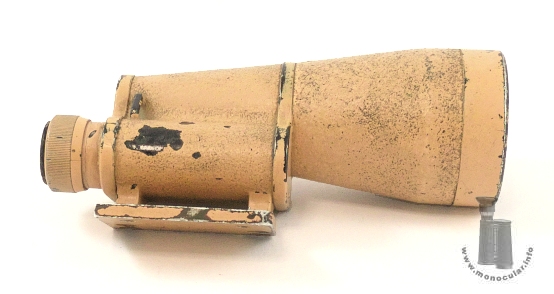Carl Zeiss Jena 15x60 ("Delfortemo")
| Das recht seltene 15x60 Monokular mit der Seriennummer 2177333 stammt aus einer Fertigungsserie von 200 Stück aus 1941. Das Mitteltriebglas "Delfortem" wurde zwischen ca. 1938 - 1943 produziert, taucht im T700 Katalog von 1940 auf, wird dort aber nicht monokular angeboten, so dass man vermuten kann, dass es als ziviles Monokular nicht auf dem Markt kam - daher ist die Modellbezeichnung "Delfortemo" auch abgeleitet von anderen Monokularmodellnamen. Das vorliegende Monokular ist sandfarben lackiert und hat einen Brückenansatz, an dem eine Befestigungsplatte vierfach angeschraubt ist. Diese Montagplatte erlaubt mit zwei weiteren Schraublöchern das Glas an einem Lichtsprechgerät als Richtfernrohr zu befestigen. Dabei ist das linksseitige Weitwinkelokular oben positioniert, weshalb der Deckel auch zum Lesen seitenrichtig graviert wurde. eine Trageriemenöse ist vorhanden. Die Deckel sind dreifach verschraubt. Die Dioptrienskala ist reicht von plus bis minus 10 und ist bei null und fünf markiert. Das Okularstück hat einen senkrecht geriffelten Fokussierungsring, die Augenmuschel fehlt. Die Lichtstärke wird im Prospekt mit 16, das Sehfeld mit 4,6° oder 80m auf 1000m angegeben. Das 15x60 wurde an den Lichtsprechgeräten 250/130 bzw. "c" (s. Zeiss Archiv Id.nr. 2844, 2824) |
The quite rare 15x60 monocular with the serial number 2177333 comes from a production batch of 200 pieces from 1941. The "Delfortem" center focus binoculars was produced from approx. 1938 to 1943. It is listed in the T700 catalog from 1940, but is not offered there as a monocular, so that one can assume that it did not come onto the market as a civilian monocular - hence the model name "Delfortemo" was never stated but coined here after other monocular model names. This monocular is painted sand-colored and has bridge bases to which a mounting plate is screwed with four screws. This mounting plate allows the glass to be attached to an optophone, i.e. light communication device as a director telescope. The plate comes with two further screw holes to attach it to the optophone. The left-hand sided wide-angle eyepiece is then positioned at the top, which is why the cover has been engraved with the Zeiss lens logo and specifications in correct position for reading while in use. There still is a strap lug. The covers have three screws. The diopter scale ranges from plus to minus 10 and is marked at zero and five. The eyepiece has a vertically knurled focusing ring, the eyecup is missing. In the catalogue the light intensity is specified as 16, the field of view as 4.6° or 80m at 1000m. The 15x60 was used on the 250/130 or "c" light communication devices (see Zeiss archive Id.nr. 2844, 2824) |




| Das 15x60 ist 210 mm lang (ohne Augenmuschel). Das Okular ist 31mm, der Fokussierungsring 36mm im Durchmesser und der Objektivtubus verbreitert sich von 56 auf 75 mm im Durchmesser. Das Gehäuse misst oben 63 x 60 mm und unten 70 x 60 mm. Die Montageplatte ist 47 x 77 mm groß. Das Monokular wiegt 773 g. | The 15x60 is 210mm long (without the eyecup). The eyepiece is 31mm, the focusing ring is 36mm in diameter and the lens tube widens from 56 to 75mm in diameter. The housing measures 63 x 60 mm at the top and 70 x 60 mm at the bottom. The mounting plate is 47 x 77 mm. The monocular weighs 773 g. |


.jpg)
Fotos: Zeun; Zeiss-Archiv

